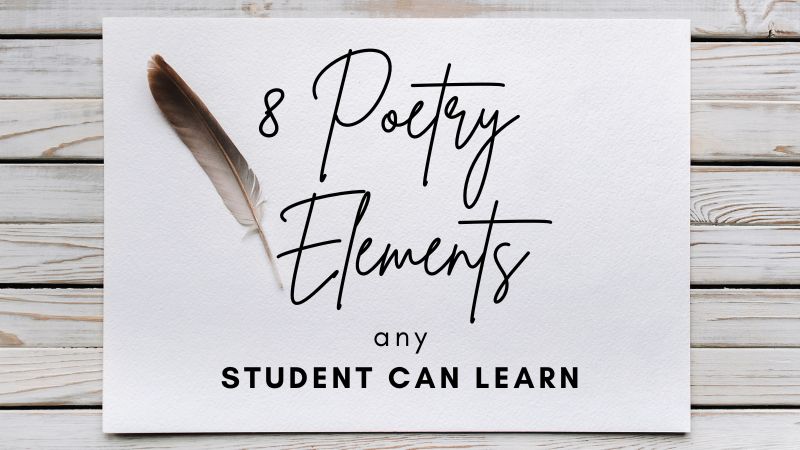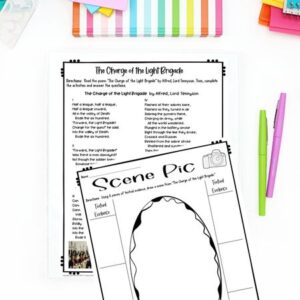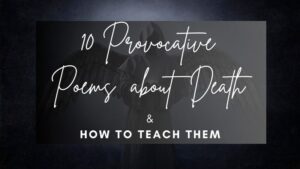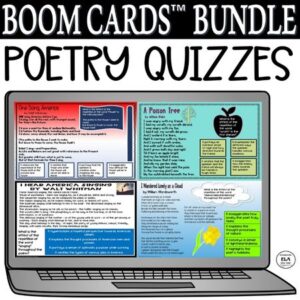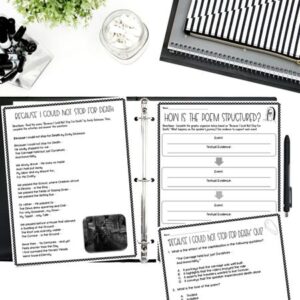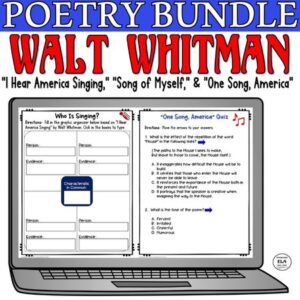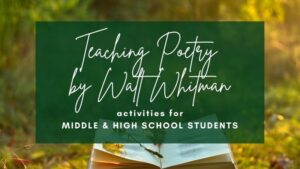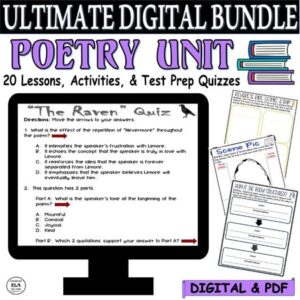As English teachers, we embrace the building blocks of literacy in all our study units. For example, with short stories, we focus on teaching plot elements to ensure our students’ comprehension, so they can ultimately deliver quality analysis. The same is true for poems and teaching poetry elements!
Students need to have at least a cursory understanding of poetry elements that can help them as they study poems, which is why teaching poetry and its building blocks is an important part of ELA!
Although students may find poetry challenging (teachers too!), looking at the parts of poems can turn this difficult process from a challenge to poetry inspiration!
And teaching poetry opens doors to diverse voices and ideas. What’s more is that if you’re in a curriculum that is not flexible, adding poems as short, complementary texts can be an ideal way to offer other points of view and creative texts.
Keep reading for 8 Poetry Elements ANY Student Can Learn!
Need help with Test Prep? Check out this FREE Pack of 3 Test Prep Activities to help students discover how to improve at reading comprehension and achieve success on standardized tests!

What are Poetry Elements?
Like plot elements such as exposition or falling action, poetry has key components that can help one understand poetry’s basics: Poetry Elements!
When students study poetry, inspiration can come from these poetry elements, which include rhyme, rhythm, and meter, as well as a myriad of figurative language devices.
And, teaching these elements is helpful for students because it’s a way to provide diverse poems and poets, more opportunities for analysis, and sometimes even a challenge for learners that encourages a growth mindset and academic risk-taking.
8 Poetry Elements ANY Student Can Learn
1. Repetition
Repetition can appear in many ways within poems, particularly by repeating words, lines, stanzas, or even ideas. Examining repetition in a poem is an ideal way to focus on impact.
Here are 2 key questions to ask students about repetition:
- What does the poet repeat?
- Why is something repeated?
Asking these questions will push students toward the poem’s meaning.
“The Charge of the Light Brigade” by Alfred, Lord Tennyson is a classic poem that uses repetition in a way that is both obvious and ultimately impactful. This poem tells the story of brave soldiers who are led into a battle they know they most likely cannot win. The repetition throughout helps to reinforce a theme relating to courage and commitment in the face of utter doom.
Below is the start of the 3rd stanza:
To track the repetition, use color coding throughout the poem. I like to create an enlarged copy of the poem so students can work on it in small groups to track all of the examples of repeated lines. The poem is also split into six sections which can make it easy to divide up for different groups (and to differentiate based on content).
Grab this poetry comprehension pack to make teaching this compelling poem about bravery in the face of certain death STRESS-FREE for you and your students! The resource uses Common Core standards and contains test prep questions and answers along with writing and visualization activities!
Need ideas for teaching poems about death? Click below!
2. Anaphora
When several lines begin with the same word or a short group of words, we have Anaphora! For example, Walt Whitman’s poems are loaded with anaphora and none more so than “I Hear America Singing!”
Print a copy of Whitman’s poem with whole groups or small groups to track his use of anaphora or even debate whether the poem is an example of anaphora since the repetition is more subtle (and slightly subverted!)! You might even use this resource for the “I Hear American Singing” as an amazing sub-plan! Everything is ready to be printed and assigned, so it’s low-prep for days when you need that option.
Want to enliven poetry test prep? Check out this BOOM Cards(TM) quiz for Walt Whitman’s “I Hear America Singing!”
3. Simile
A simile is a comparison of two things using the words like or as designed to emphasize a specific idea. Poems are often filled with similes and students are quick to identify them, but are they as skilled in understanding the comparisons? This analysis is where exploration in repeated ways is necessary to improve their skills beyond just recognition.
The poem such as “I Wandered Lonely as a Cloud” by William Wordsworth includes a simile in its title but is more subtle in its comparisons! Teaching this text is a great way to challenge students of all skill levels.
Ex. I wandered lonely as a cloud / That floats on high o’er vales and hills…
There is a comparison between the speaker and a cloud, and this comparison helps to emphasize the speaker’s loneliness in a solitary setting!
This resource with the full poem along with activities including a set of questions and answers can support all students (and help teachers with a ready-to-go resource!).
Thought about using BOOM Cards to make teaching poetry fun? See below!
4. Metaphor
Metaphor is the comparison between two unlike things such as those used in the poem “Mother to Son” by Langston Hughes. The poem not only includes a variety of metaphors but is itself an extended metaphor with a comparison of life to stairs. Another option is to include the aptly named poem “Metaphors” by Sylvia Plath.
With either poem, have students track and then explain the metaphors used. They can examine whether all of the metaphors work together to form a single meaning (or even tone) or if they are more individualistic and extend beyond a single holistic meaning.

5. Personification
When things or abstract ideas are given human characteristics such as stars dancing in the night, this technique is called personification. It is one of the most interesting poetry elements to both explore and create.
Before students write their own poems by utilizing poetry elements, they can gain poetry inspiration from completing activities with Emily Dickinson’s “Because I Could Not Stop For Death” or even “Death Be Not Proud” by John Donne.
Check out this 1st stanza from “Because I Could Not Stop for Death:”
For each resource, the poem contains an annotated version to make your life easier! With each one, students answer questions, explore the language, and visualize the content. All is done with a focus on citing evidence and examining theme, structure, tone, and words/phrases directly from the full text of each poem.
6. Hyperbole
Hyperbole is a form of exaggeration that can be used both positively and negatively. Poems such as Robert Frost’s “Nothing Gold Can Stay” (a great companion piece when studying The Outsiders by S.E. Hinton) or “As I Walked Out One Evening” by W.H. Auden (a classic love poem that is filled with hyperbole!).
Hyperbole can be presented in varying degrees. Auden’s poem includes over-the-top demonstrations of love such as when the speaker indicates they’ll love someone until “the salmon sing in the street.” But more subtle hyperbole is included in Wordsworth’s “I Wandered Lonely As A Cloud” with lines like “They stretched in a never-ending line” or “Ten thousand I saw at a glance” that are certainly exaggerations but not earth-shattering ones.
For students to best understand the degrees of hyperbole they can create a listed hierarchy of examples such as those included in poems by Auden, Frost, or Wordsworth. Once they create the hierarchy, they can parody the lines by exaggerating the exaggerations. For example, shift Wordsworth’s subtle lines into great exaggerations like Auden’s or vice versa. This creative exercise always incites some laughs in my poetry units!
7. Imagery
Imagery is the use of vivid language and sense-based description to create a picture (an image!) in the reader’s mind, and it is likely the most prevalent of the poetry elements. A picture is worth a thousand words, but luckily most poems create pictures using far less wording!
Take “Ozymandias” by Percy Bysshe Shelley as an example. Within his 14 lines, he creates a moving image of a statue of Ozymandias (also known as Ramesses II). (Check out an actual photograph of the statue here and you can use this photo as a comparison for students to use with the poem.) This print-and-go set of comprehension and response activities can support your students’ understanding of the poem, reinforce poetry elements analysis, and save you tons of time as well!
8. Allusion
An allusion is a brief reference to a person, event, or work of literature, including other poems. This poetry element can be a difficult one for students since older poems’ references are either specific to their time or even further back into history.
To help combat this additional challenge with any poem, background information can be key to understanding allusion. Begin by picking a poem. This list of options is a great starting point. Then, there are a couple of ways to use this approach with poems that feature allusions.
First, provide the poem without added information to students and have them go through and pick out what they think might be allusions. Have them explain what they think the allusion is in a couple of sentences. Then, encourage students to complete some quick online research to see if they’re right. Examining the correct and incorrect answers will provide valuable information to students that can be applied to further poems.
The second way is to provide a list of allusions and their possible explanations. Like in the game Balderdash(TM), you can include real and fake options to challenge students. These explanations can be short readings like the opening paragraph from Wikipedia entries. Students then match the allusion to the poem. I like to do this in small groups where students can benefit from collaboration in accomplishing the task.
Sure, poetry elements can be challenging but they can also be FUN! Teaching poetry elements remains an integral part of ELA for a variety of reasons including its challenging content and its ability to shift from serious to fun (even within the same poem!).
Have you thought about teaching classic poetry by Walt Whitman? Click below to read about incorporating these American classics!
Why Should You Still Teach Poetry Elements?
We come into contact with poetry elements ALL of the time! Most songs, children’s books, and speeches include poetry elements, and we may not even recognize them in the moment. But trust me; if you listen closely, you will begin hearing them more and more!
Teaching poetry throughout the year within an integrated unit is a MAJOR help in reinforcing poetry elements!
Just remember. There is always a purpose behind the use of poetry elements! Dig a little, and you will find it!
Poetry Elements Resource
If you are looking to reduce your challenge in teaching poetry elements, check out this bundle of 20 lessons featuring a wide variety of poems. It includes 215 Common Core style questions and answers, 20 short response questions with examples and rubrics, and answer keys – with detailed explanations – for teachers. Plus, it has various poetry activities explained in suggested detailed lesson plans that also outline applicable standards!
It is a HUGE bundle that can be used this year and for years to come to teach poetry elements and find poetry inspiration, too!
Want more help with teaching poetry elements? Check out my store, Kristin Menke-Integrated ELA Test Prep!

